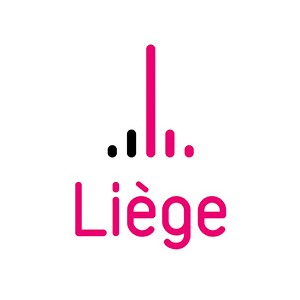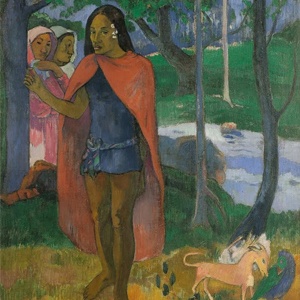The acquisitions by Liège at the sale of “degenerate art” in Lucerne
On 30th June 1939, in Lucerne, art dealer Theodor Fischer wrote a dark chapter in the history of 20th century art by auctioning off one hundred and twenty-five “masterpieces of modern art” pilfered from German museums by the government of the Third Reich, works by the great artists of the era but qualified as “degenerate” by the Nazi “philosophers”. Sixteen of the eighty-five lots under the hammer found their way to Belgium, including nine, amongst the most ought after, which were acquired by the City of Liège. Among these trophies, six works at least are major landmarks in the careers of their creators: The Blue House by Marc Chagall, Death and the Masks by James Ensor, The sorcerer of Hiva Oa by Paul Gauguin, Monte-Carlo by Oscar Kokoschka, Horses Grazing by Franz Marc and The Soler Family by Pablo Picasso. The others, Portrait of a Young Girl by Marie Laurencin, Rider on the Beach by Max Liebermann and Lunch Room by Jules Pascin are at the very least typical of each of their creator’s specific styles.
These acquisitions were the fruit of a coalition between Liège’s key players: politicians (Auguste Buisseret, Jules Duesberg, Olympe Gilbart), industrialists (Paul de Launoit, Louis Lepage) and cultural leaders (Jules Bosmant, Jacques Ochs).
In 1939, Liège seemed finally to be recovering from the consequences of the Great War and the depression of 1929. Already marked by the International Water Fair, the construction of the Léonie de Waha high school, superbly decorated by a whole host of paintings and sculptures from Liège, and that of the Sauvenière covered swimming pool, the cultural footprint of this already buoyant year was further enhanced thanks to the Lucerne sale.
In May 1939, the teacher and art critic Jules Bosmant, who later went on to preside over the destiny of the Fine Arts Museum, announced the sale to Auguste Buisseret, a liberal councillor in charge of Fine Arts, recently elected as a senator (on 2nd April of the same year) and a future minister and mayor. He had the backing of Jacques Ochs, director of the Fine Arts Academy and Museum since 1934, as well as a famous caricaturist for the Pourquoi pas? journal. Without procrastination, Buisseret managed to convince a group of benefactors to provide their support. Identified under the name of the Amis des Musées liégeois (friends of the museums of Liège) and represented by Baron Paul de Launoit, head of the Cofinindus-Brufina-Banque de Bruxelles group (the second biggest holding in the country, after Société générale) and the Société Ougrée-Marihaye (a flagship of the Belgian metallurgy industry), as well as by the engineer Louis Lepage, founder, amongst others, of the chemical company Société belge de l'Azote, these benefactors undertook to make available to the City of Liège the sum of five million Belgian Francs (the equivalent of more than 3,800,000 euros today and 754,774 Swiss Francs at the time), as a donation or advance. Based on a report by Jules Bosmant covering the estimation and state of the works as well as the encouraging results of negotiations made with potential purchasers in order to “define [...] each person’s sector of interest and thus curb the auction amounts, so as to provide as little as possible in foreign currency to the Nazi’s funds”, Buisseret managed at the very last moment on 26th June to persuade Jules Duesberg, the new minister of public education (appointed on 16th April) and vice-chancellor of the University of Liège, to grant a new subsidy of one and a half million Belgian Francs. It was ultimately the day before the sale that the city council unanimously approved (including five Rexist votes!) the provision of a subsidy totalling 1,750,000 Belgian Francs and the definitive settlement of the financial arrangements for the operation: the City’s contribution was set at 35% of expenditure, 30% were guaranteed by the State and 35% by the private benefactors, who, as initially agreed, advanced the total sums required.
Forging ahead, Buisseret, Gilbart and Ochs went to Paris in August 1939, and brought back nine paintings: Shells and Shellfish by James Ensor, The Port of Antwerp by Othon Friesz, Peasant with Fagot by Marcel Gromaire, Lock at the Bouchardon Mill at Crozant by Armand Guillaumin, Nude by Charles Picart Le Doux, Comblat castle by Paul Signac, Moulin de la Galette by Maurice Utrillo, The Violinist by Kees Van Dongen and Red Flowers by Maurice de Vlaminck.
In light of the cost of this second wave of purchases (186,231 Belgian Francs), the theoretically available reserve was still in the region of four million francs. However, after the war, neither the City nor the State were able to enter the slightest participation into their budgets, which consequently brought an end to the agreement made with the Friends of the Museums.
In terms of cultural policy, the purpose of the purchases in 1938 and 1939 was clearly explained by both those involved as well as journalists to whom they were close. Auguste Buisseret summarised it bluntly in the speech that he gave during the official presentation of the paintings bought in Lucerne. Seeking to enhance the city’s collections, he intended to deploy his actions in two directions: to highlight the efforts of the people of Liège over the centuries and to intensify the interest in “modern art from the impressionists until the most recent masters, especially those of the Paris School”. These two directions were encompassed in a single approach: “By making Liège a centre for arts open to all the movements of modern aesthetics, we will indirectly contribute, but with ten times the efficiency, to increasing the output and reinforcing the influence of the spirited School of Liège. We will attract to our venues, monuments and museums, to the workshops of our artists, to our concert halls and theatres [...] the inquisitive, tourists and art lovers”.
Was it really necessary to swell the Nazi war chest? The anti-Nazi motivation of the originators of these purchases should be underlined, in particular in the person of Jules Bosmant, co-founder in Liège of the Comité de Vigilance des Intellectuels antifascistes (the anti-fascist intellectuals’ monitoring committee) and the Ligue contre le Racisme et l'Antisémitisme (league against racism and anti-Semitism), as well as that of Jacques Ochs, a political prisoner at the Breendonk Fort, sentenced to death in 1944, and also Auguste Buisseret, the first Belgian politician to be arrested by the occupier in 1940. This dimension was encapsulated in the eyes of the local press, which presented the purchases of Liège as a response to a “crime against the mind”. Also at stake was the fate of the “degenerate” artists: “You should have seen the impact when an artist’s work was not purchased: it was like a death sentence,” noted a witness to the sale.
Jean-Patrick Duchesne (1957 - 2018)
Professor at the University of Liège
Contact : aW5mb0BsYWJvdmVyaWUuY29t



